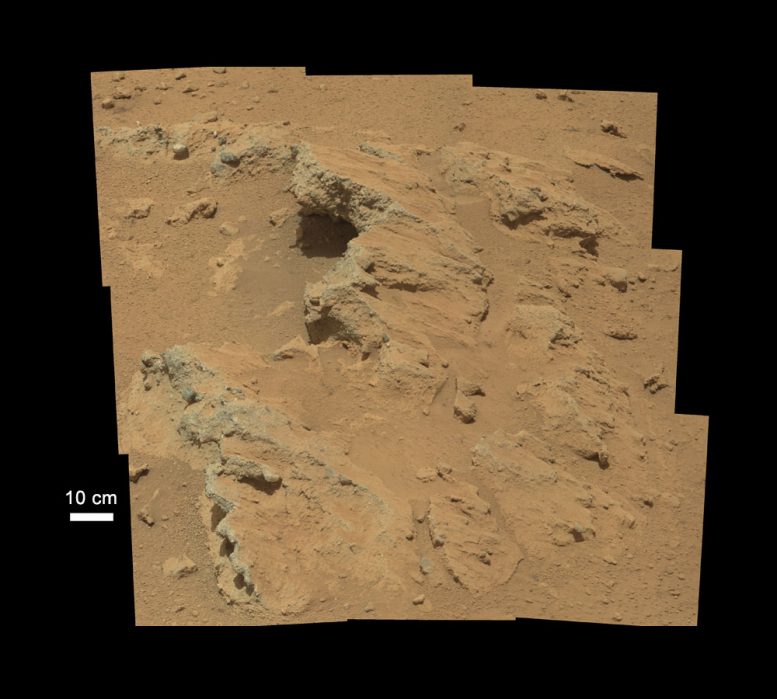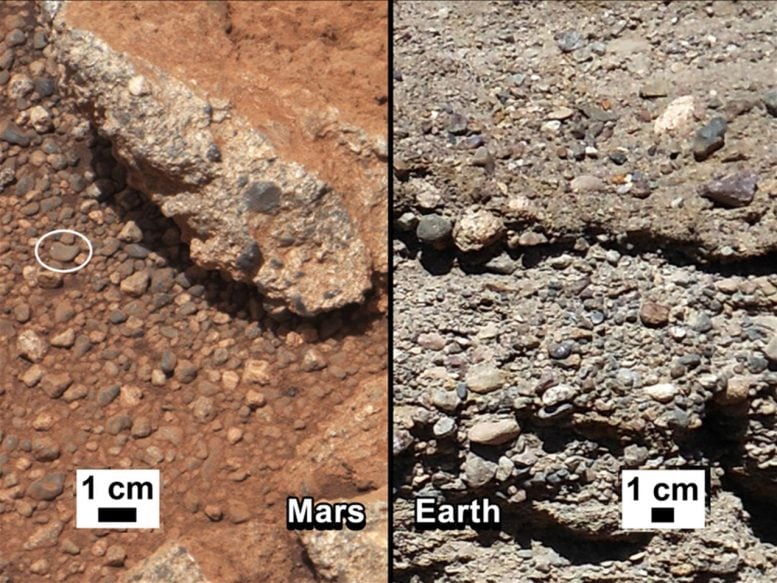
NASA’s Curiosity rover found evidence for an ancient, flowing stream on Mars at a few sites, including the rock outcrop pictured here, which the science team has named “Hottah” after Hottah Lake in Canada’s Northwest Territories. Credit: NASA/JPL-Caltech/MSSS
While examining two outcrops, called “Hottah” and “Link,” NASA’s Curiosity rover found evidence that a stream once ran between the north rim of Gale Crater and the base of Mount Sharp.
NASA’s Curiosity rover mission has found evidence a stream once ran vigorously across the area on Mars where the rover is driving. There is earlier evidence for the presence of water on Mars, but this evidence — images of rocks containing ancient streambed gravels — is the first of its kind.
Scientists are studying the images of stones cemented into a layer of conglomerate rock. The sizes and shapes of stones offer clues to the speed and distance of a long-ago stream’s flow.
“From the size of gravels it carried, we can interpret the water was moving about 3 feet per second, with a depth somewhere between ankle and hip deep,” said Curiosity science co-investigator William Dietrich of the University of California, Berkeley. “Plenty of papers have been written about channels on Mars with many different hypotheses about the flows in them. This is the first time we’re actually seeing water-transported gravel on Mars. This is a transition from speculation about the size of streambed material to direct observation of it.”
The finding site lies between the north rim of Gale Crater and the base of Mount Sharp, a mountain inside the crater. Earlier imaging of the region from Mars orbit allows for additional interpretation of the gravel-bearing conglomerate. The imagery shows an alluvial fan of material washed down from the rim, streaked by many apparent channels, sitting uphill of the new finds.
The rounded shape of some stones in the conglomerate indicates long-distance transport from above the rim, where a channel named Peace Vallis feeds into the alluvial fan. The abundance of channels in the fan between the rim and conglomerate suggests flows continued or repeated over a long time, not just once or for a few years.
River Fans on Earth and Mars: Curiosity science team member William Dietrich explores the relationship between river fans found in California’s Death Valley on Earth and similar fans in Gale Crater on Mars. Credit: NASA/JPL-Caltech
The discovery comes from examining two outcrops, called “Hottah” and “Link,” with the telephoto capability of Curiosity’s mast camera during the first 40 days after landing. Those observations followed up on earlier hints from another outcrop, which was exposed by thruster exhaust as Curiosity, the Mars Science Laboratory Project’s rover, touched down.
“Hottah looks like someone jack-hammered up a slab of city sidewalk, but it’s really a tilted block of an ancient streambed,” said Mars Science Laboratory Project Scientist John Grotzinger of the California Institute of Technology in Pasadena.
The gravels in conglomerates at both outcrops range in size from a grain of sand to a golf ball. Some are angular, but many are rounded.
“The shapes tell you they were transported and the sizes tell you they couldn’t be transported by wind. They were transported by water flow,” said Curiosity science co-investigator Rebecca Williams of the Planetary Science Institute in Tucson, Arizona.
The science team may use Curiosity to learn the elemental composition of the material, which holds the conglomerate together, revealing more characteristics of the wet environment that formed these deposits. The stones in the conglomerate provide a sampling from above the crater rim, so the team may also examine several of them to learn about broader regional geology.
The slope of Mount Sharp in Gale Crater remains the rover’s main destination. Clay and sulfate minerals detected there from orbit can be good preservers of carbon-based organic chemicals that are potential ingredients for life.

This set of images compares the Link outcrop of rocks on Mars (left) with similar rocks seen on Earth (right). Credit: NASA/JPL-Caltech/MSSS and PSI
“A long-flowing stream can be a habitable environment,” said Grotzinger. “It is not our top choice as an environment for preservation of organics, though. We’re still going to Mount Sharp, but this is insurance that we have already found our first potentially habitable environment.”
During the two-year prime mission of the Mars Science Laboratory, researchers will use Curiosity’s 10 instruments to investigate whether areas in Gale Crater have ever offered environmental conditions favorable for microbial life.
NASA’s Jet Propulsion Laboratory, a division of Caltech, built Curiosity and manages the Mars Science Laboratory Project for NASA’s Science Mission Directorate, Washington.









Water on Mars suggests that water is an extra-planetary origin, coming from Oort Clouds carrying ice and rocks through cometary debris which impinges on terrestrial planets to give an atmosphere of watery cloud and responsible for oceans and rivers. Earlier to Earth some 3.5 billiion years ago, the temperature on Mars was just suitable for formation of watery clouds and oceans when our earth was a simmering hot oven. Mars was just habitable with a heavenly look as earth. Even life could have existed and with temperature reaching -50 degree celcius, tha planet has become dead with all the water freezing under the soil mixed with carbon-dioxide and other gases frozen along with it. When earth is cooled and dead, can we expect activity on Venus next? No doubt water will be supplied by comets in course of time making an impact with the planet. Only the right temperature is required for life formation. Even the basic amino acids required for life formation should have been synthesised outside the planets in the vast expanse of gases which failed to become stars undergoing chemical combinations helped by high power gamma radiation. Oh, Water , Water everywhere but not a drop to drink! Photos are quite splendid and rocks and pebbles speak of the riven flow. Thank You.